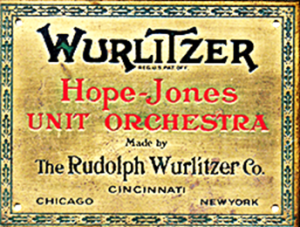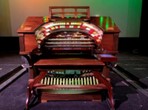The Colonial Wurlitzer Opus 585


This beautifully restored 1922 Wurlitzer 3 manual 24 rank theatre organ is located at the Colonial Theatre at 227 Bridge Street in Phoenixville PA. It is a perfect fit in the historic 658 seat 1903 theatre. There are few places where you can still experience and appreciate the sonic power of the Mighty Wurlitzer in an historic building designed for acoustic instruments. You can hear, and even play, this amazing pipe organ during the many scheduled events. Stored beneath center stage on an elevator lift, the organ console rises into view as the artist plays his or her opening song.
History of the Roland Kurek Memorial Wurlitzer at the Colonial Theatre
On July 20, 2000, the Theatre Organ Society of the Delaware Valley entered into an agreement with the Association for the Colonial Theatre to install a pipe organ owned by TOSDV in the1903 Auditorium of the theatre located in the Borough of Phoenixville, Pa. The purpose of the installation would be to enhance the diversity and quality of the theatre’s presentations. The agreement also provided the Theatre Organ society the opportunity to hold four organ concerts each year, open to the public. Although the Theatre Organ society had a two-manual, 17 rank, Wurlitzer Organ in hand and planned for this project, in January of 2002, it was learned that a more desirable instrument could possibly be obtained.
Wurlitzer Opus 585, originally an 18 rank, 260 Special model organ, has had an interesting history. It was built for and originally installed in Shea’s Hippodrome Theatre in Buffalo, New York in 1922. The organ remained in the theatre for 35 years until 1957, and was played by many famous organists during this period. In May of 1957, the organ was purchased by Harold Logan of Niagara Falls, Ontario and installed in his residence. In 1974, Bob Breuer had plans to build a “Pizza & Pipes” restaurant in Fresno, California and purchased the instrument from Logan. In March of 1977, the new restaurant opened, and the instrument came back to life. By this time, it had been expanded to 23 ranks.
The restaurant was very successful, and the organ was played on a daily basis for 22 years until January of 1999 when the restaurant closed. At this time, a young theatre organ enthusiast from New Jersey, by the name of Roland Kurek heard that Opus 585 was for sale. He went to Fresno, saw and heard the organ, and bought it on the spot. He had it dismantled, packed and shipped to a storage area near his home in Manasquan, N.J. His dream was to have the organ installed in a public place so it could be enjoyed by everyone. Unfortunately, Mr. Kurek fell ill shortly after the organ purchase, and passed away in March of 2000, never to realize his dream. In his estate plan he stipulated that the organ be given to a worthy individual or organization which would keep it intact and install it in a place where it could be enjoyed by the public.
Starting negotiations in January 2002 with those responsible for settling the Kurek estate, the proposal by the Theatre Organ Society of the Delaware Valley to install Wurlitzer Opus 585 in the Colonial Theatre was finally accepted and the organ officially passed to the society on August 3, 2003. A generous endowment from the Kurek estate also accompanied the organ to aid in its restoration and installation.
This organ is a true theatre organ in every respect, including all of the customary traps, tuned percussions and sound effects. The instrument was moved from its storage location in New Jersey and preliminary work on the installation was begun.
As mentioned above, a trust fund was set up by the Kurek estate to aid in the Wurlitzer’s restoration and installation. However, the available funds were not sufficient to allow for all work to be done by paid professionals. A TOSDV budget was prepared to make use of the trust fund money for those areas of the project requiring professionals, with volunteers utilized for other tasks wherever possible. Approximately 40% of the money in the budget was required for a new solid-state relay switching system and combination action, re-leathering supplies and parts, and console hardware. The remaining funds were allocated to pay for professionals to re-leather the main chests and reservoirs, install the new solid -state components in the console, set up and shop test the organ, and install all of the main components in the theatre. Volunteer tasks included re-leathering the off-set chests and tuned percussions, renovating the organ chambers, washing and repairing the pipework, refurbishing the console, preparing the cabling, and aiding in the installation. As part of the project another set of pipes was added, bring the specification up to 24 ranks. The organ also now features an accordion, playable from the console, one of the few instruments in the world with this feature.
This was a very exciting and interesting project. After 10 years of hard work by members of TOSDV, the fully restored organ made its debut on September 15, 2012. This installation jumpstarted the yearly TOSDV programming of concerts by well-known artists, silent film accompaniments, and open consoles. TOSDV takes great pride in keeping this instrument in concert ready condition for these ongoing events. My thanks to all those who became a part of this project. It was a great thrill when we finally got to enjoy the fruits of our labor at the dedicatory concert.
Jack Serdy
Retired Organ Technician, Project Crew Chief
__________________________________________________________________________________________
Roland Kurek Memorial Wurlitzer Opus 585
| Solo Chamber
|
Main Chamber
|
||
| 8′ Vox Humana | 61 Pipes | 8′ Clarinet | 61 Pipes |
| 8’Orchestral Oboe | 61 Pipes | 8′ Quintadena | 61 Pipes |
| 8’Brass Saxophone | 61 Pipes | 8′ Salicional | 73 Pipes |
| 8′ Brass Trumpet | 61 Pipes | 8’Salicional Celeste | 61 Pipes |
| 8′ Solo String | 85 Pipes | 8′ Open Diapason | 85 Pipes |
| 8′ Oboe Horn | 61 Pipes | 8′ VDO | 85 Pipes |
| 8′ Kinura | 61 Pipes | 8′ VDO Celeste | 73 Pipes |
| 8’MortonTuba Mirabilis | 61 Pipes | 8′ Vox Humana | 61 Pipes |
| 8’SoloString Celeste | 61 Pipes | 8′ Krumet | 61 Pipes |
| 16′ Tibia Clausa | 97 Pipes | 8′ Tibia Clausa | 85 Pipes |
| 16′ Post Horn | 73 Pipes | 16′ Tuba Horn | 73 Pipes |
| 16’Diaphonic Horn Diap | 73 Pipes | 16′ Bourdon/Concert Flute | 97 Pipes |
Total Pipes: 1692
|